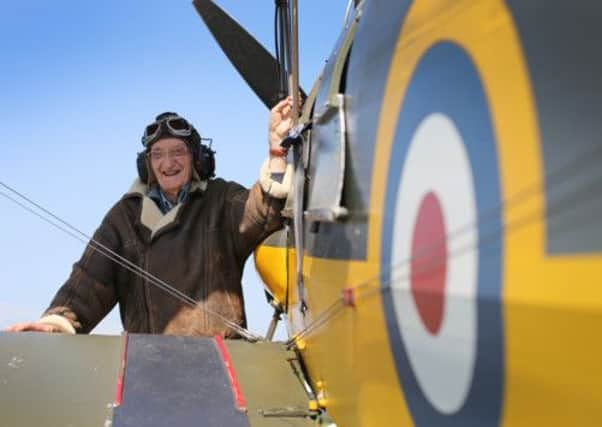Still reaching for the sky aged 90


On his latest aerial adventure, Mr Lamprey, who had not been at the controls of an aircraft for nearly 70 years, enjoyed a fully aerobatic flight and even looped the loop over the Peak District.
And the daredevil pensioner who sat at the front of the open-top Tiger Moth could not resist begging his instructor to push the aircraft to its limits.
Advertisement
Hide AdAdvertisement
Hide AdFlight Lieutenant Lamprey was taught to fly a Tiger Moth after he decided to become a pilot when he was drafted in 1942.
But despite his seven-decade absence from the skies, the pensioner said he instantly remembered how to use the controls of the aircraft when he clambered back on board.
“It doesn’t seem over seventy years since I first soloed in one,” he said. “Flying is very nostalgic.
“I remembered the controls instantly – it’s like riding a bike.
Advertisement
Hide AdAdvertisement
Hide Ad“The first time I flew a Tiger Moth it was scary. I’d never flown before. It looked and felt very big.
“When I first went solo my instructor said, ‘you’ll be OK’ but warned me it would feel lighter with just me in it.
“I was fifteen feet too high for my first landing and had to go round again
“We used to fly them from the back seat sitting on our parachute to give us a better view.”
Advertisement
Hide AdAdvertisement
Hide AdMr Lamprey, from Ackworth, near Pontefract, celebrated his 90th birthday with an “experience” flight in the 1940 Tiger Moth last year and is now a firm favourite at the Netherthorpe Airfield near Worksop where he has also taken staff on a trip down memory lane by showing them his wartime photos and his paperwork.
Flying instructor Will Flanagan was amazed to learn about his past experience.
“He’s got the lightest of touch,” he said. “It’s like with golf – it’s technique not strength that counts.
“He’s so sharp he must have been an amazing pilot in his day.
Advertisement
Hide AdAdvertisement
Hide Ad“The exam papers he showed us looked much harder than those we use today. It really is an honour to have him in our Tiger.
“He keeps in touch with us all the time now and we look forward to taking him up many more times.
“You’d not know he was 90 – he jumped out of the aircraft today like a much younger man.”
Mr Lamprey, who now lives in Upton, originally wanted to fly Mosquitos with his friend, who was later killed in one.
Advertisement
Hide AdAdvertisement
Hide AdThe selection process began in 1942, when he was 19 and was put through a series of tough medical and physical tests.
“We had to be good at maths too,” he added. “I was asked to guess the length of a telegraph pole outside and how to work out the volume of the inkwell on the desk. I was lucky I’d just finished school so it wasn’t too hard.”
Mr Lamprey was then put on a Pilot Navigator and Bomb Aimer course and sent to the Aircrew Receiving Centre at Lord’s Cricket Ground where his night vision was tested.
His initial training was in Scarborough, where he and other pilots learned meteorology, navigation, armament, signals and aircraft recognition, getting his Kaypook (inner flying suit) and kit three months later.
Advertisement
Hide AdAdvertisement
Hide AdHaving passed his training, he was sent to Manchester for a unit for overseas postings and then drafted to Canada, where he passed out second of 30 pilots and was awarded his wings.
The pensioner said: “The war ended and these aircraft became surplus to requirements. I flew one to Lough Erne in Ireland to be scrapped.
“I remember meeting Douglas Bader when I was on standby to be sent to an active squadron in South Africa and then India but both of these were cancelled because the squadrons were coming home.
“Bader was a single-engine fighter pilot and didn’t think highly of us multi-engine boys.”
Advertisement
Hide AdAdvertisement
Hide AdAfter the conflict ended Fred returned to being a fitter. He then worked for Hoover before starting up his own business.
Fred was married to Betty for over 55 years.
He has a daughter, Denise, and grandson called Rob.